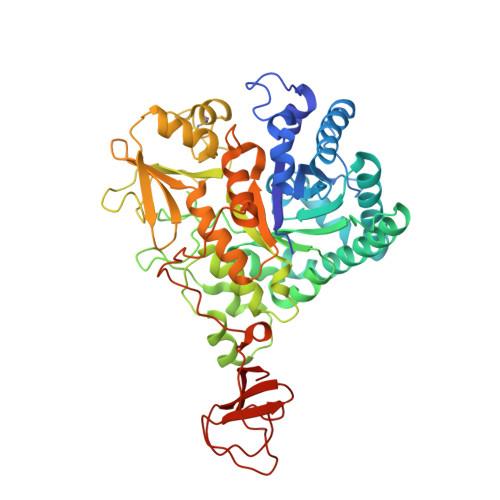Interactions of a Family 18 Chitinase with the Designed Inhibitor Hm508 and its Degradation Product, Chitobiono-Delta-Lactone.
Vaaje-Kolstad, G., Vasella, A., Peter, M.G., Netter, C., Houston, D.R., Westereng, B., Synstad, B., Eijsink, V.G.H., Van Aalten, D.M.F.(2004) J Biological Chem 279: 3612
- PubMed: 14597613
- DOI: https://doi.org/10.1074/jbc.M310057200
- Primary Citation of Related Structures:
1UR8, 1UR9 - PubMed Abstract:
We describe enzymological and structural analyses of the interaction between the family 18 chitinase ChiB from Serratia marcescens and the designed inhibitor N,N'-diacetylchitobionoxime-N-phenylcarbamate (HM508). HM508 acts as a competitive inhibitor of this enzyme with a K(i) in the 50 microM range. Active site mutants of ChiB show K(i) values ranging from 1 to 200 microM, providing insight into some of the interactions that determine inhibitor affinity. Interestingly, the wild type enzyme slowly degrades HM508, but the inhibitor is essentially stable in the presence of the moderately active D142N mutant of ChiB. The crystal structure of the D142N-HM508 complex revealed that the two sugar moieties bind to the -2 and -1 subsites, whereas the phenyl group interacts with aromatic side chains that line the +1 and +2 subsites. Enzymatic degradation of HM508, as well as a Trp --> Ala mutation in the +2 subsite of ChiB, led to reduced affinity for the inhibitor, showing that interactions between the phenyl group and the enzyme contribute to binding. Interestingly, a complex of enzymatically degraded HM508 with the wild type enzyme showed a chitobiono-delta-lactone bound in the -2 and -1 subsites, despite the fact that the equilibrium between the lactone and the hydroxy acid forms in solution lies far toward the latter. This shows that the active site preferentially binds the (4)E conformation of the -1 sugar, which resembles the proposed transition state of the reaction.
- Department of Chemistry and Biotechnology, Agricultural University of Norway, N-1432 As, Norway.
Organizational Affiliation:




















